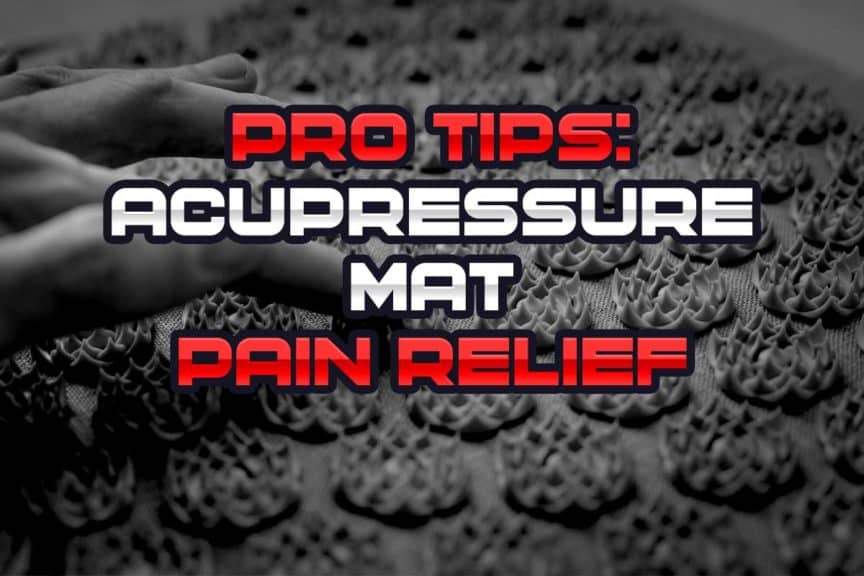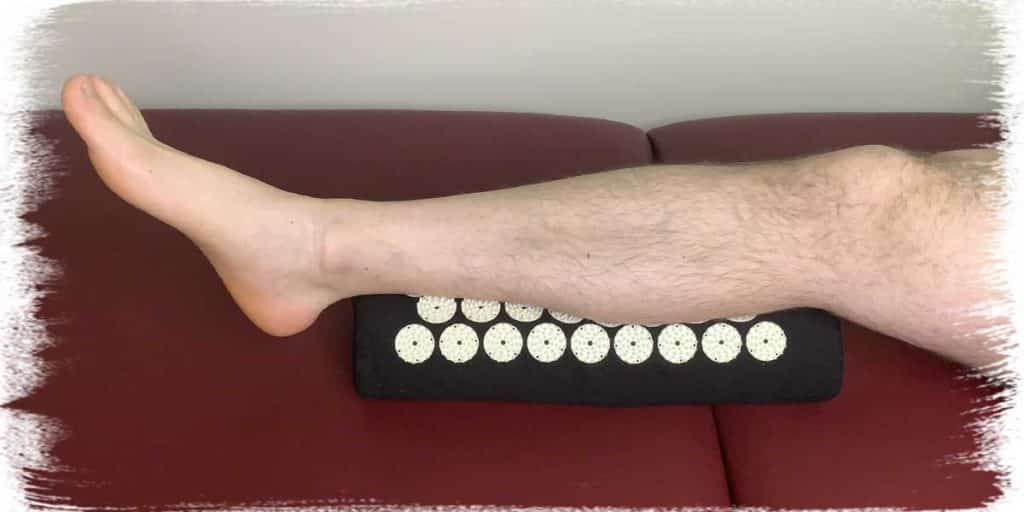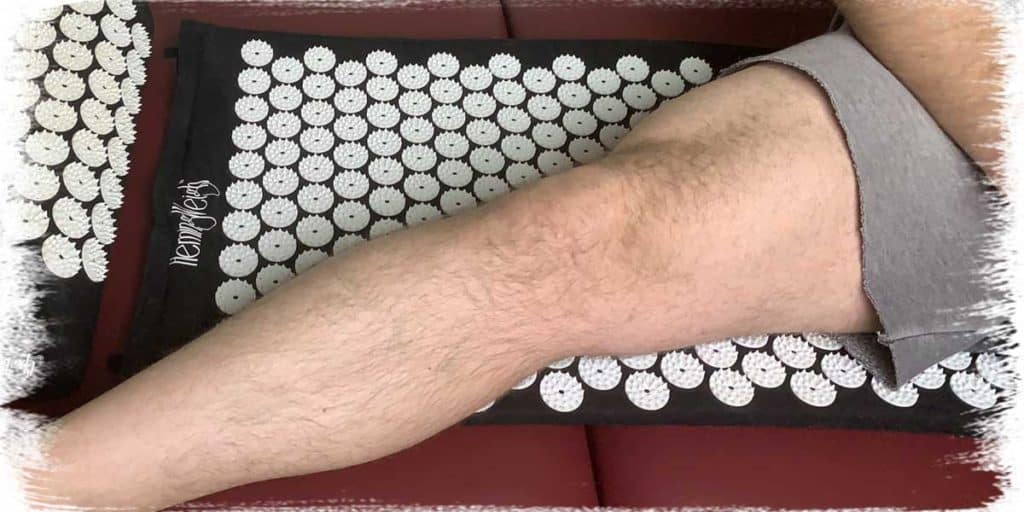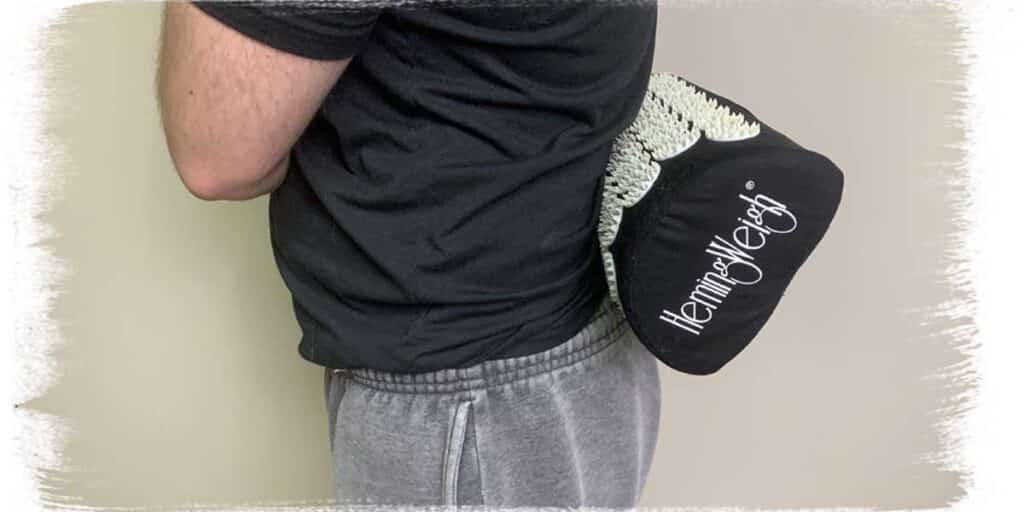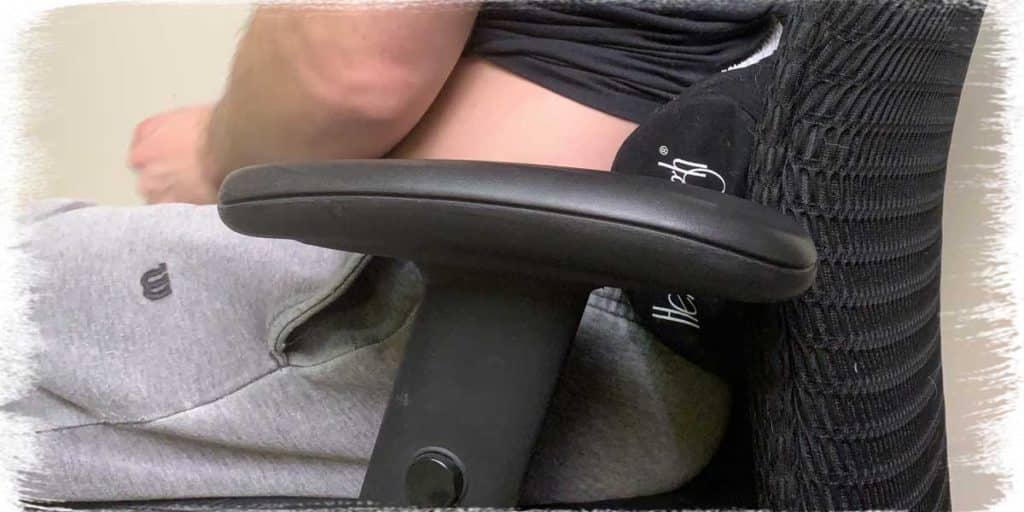Back in my younger days, I used to think that anything in the acupressure world was something worthy of scoffing at – mainly because I was uninformed and perhaps a bit arrogant. Maybe I thought it wasn’t “hardcore” enough for me, or maybe I just had a misinformed understanding of them. Either way, I’ve long since changed my beliefs – nearly every tool has a time and a place, and the acupressure mat is no different.
To get the most pain relief possible from an acupressure mat, it needs to be used consistently, on multiple body parts, with variable pressure, and in conjunction with deep breathing exercises. Using the mat while combining these tactics can ensure much greater pain-relieving benefits.
If you want to learn all of these factors in greater detail, keep on reading as I’ll be covering the specifics for each one, which will help ensure that you get the absolute most pain relief possible from your acupressure mat!
ARTICLE OVERVIEW:
Click/tap on any of the article headlines below to instantly jump to that section of the article.
The basics: how to use an acupressure mat
Tip 1: Use your mat consistently
Tip 2: Use it on multiple body parts
Tip 3: Know how to vary the pressure
Tip 4: Use it in conjunction with deep breathing exercises
Tip 5: Keep using it to prevent the problem from returning
Bonus tip: Use an acupressure neck pad on your low back
For the sake of this article, the tips I’ll be going over apply to any area of your body that you intend on using your acupressure mat for. This can be your back, the bottoms of your feet, your neck, your calves, etc. Just make sure the area you’re planning on treating is appropriate to do so.
Related article: Six Benefits of Using an Acupressure Mat for Your Aches and Pains
As well, I’ll quickly mention that I’m addressing the usage of an acupressure mat more so from a western medicine standpoint rather than an eastern, traditional Chinese medicine standpoint. The reason simply being I’m trained up in more of a western medicine standpoint and understand the potential benefits of acupressure mats from this western realm as opposed to Qi, meridians, or life energy, which are often emphasized in the eastern realm.
Disclaimer: While I am a physical therapist, I am not YOUR physical therapist. As a result, I cannot tell you whether or not any treatments mentioned on this website or in this article may or may not be appropriate for you, including using an acupressure mat. By following any information within this post, you are doing so at your own risk. You are advised to seek appropriate medical advice for any pain you may be experiencing.
The Basics: How to use an acupressure mat
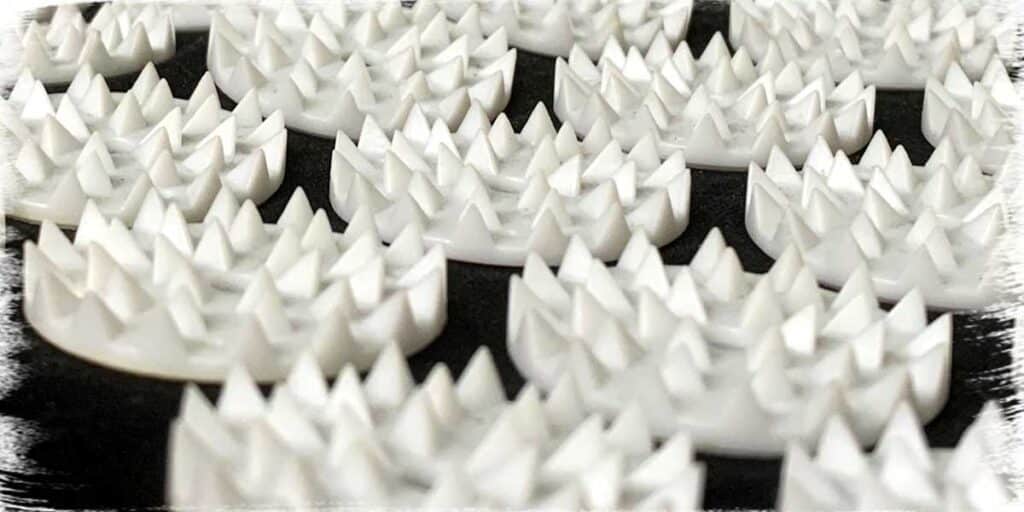
The tips covered in this article won’t do you much good if you aren’t exactly sure how to use an acupressure mat. While I’m assuming that you already have a good understanding, I’ll quickly go over the basics if you feel unsure about how to use one.
General intended usage
Acupressure mats are designed to offer pain relief from pain arising from musculoskeletal issues (muscles and tendons, in this case). Muscles and their associated tendons and tissues can get tight, achy, and painful for several reasons. In the absence of traumatic injury, it’s often due to factors such as overuse, poor postural habits, lack of physical strength, or lack of physical activities and movement.
Acupressure mats are designed to help combat the pain arising from these particular issues by improving blood flow to the area(s) that may be tight, weak, restricted, or otherwise unhealthy (all of which likely leading to pain). This improvement in localized blood flow can create a healthier environment for these tissues, which can help restore the targeted tissues’ health and mobility while subsequently reducing or eliminating pain.
They are also designed to provide pain relief by stimulating endorphin release within our body. Endorphins are essentially chemicals in the body that can help block out pain and subsequently help us feel better for a certain length of time.
Tiny little spikes achieve the effects of enhanced blood flow and endorphin release on the mat that stimulate the skin via the pressure they provide when laying or placing a specific body part on these spikes.
General guidelines
Keep the following guidelines in mind as you read through the following tips and use your acupressure mat on your own body:
- Keep the body part that you’re placing on the mat still – moving when you have pressure on the mat won’t feel too comfortable.
- You can vary the time that you use the mat, but ideally, 20-30 minutes should suffice. If you haven’t used a mat before, you may want to start with a shorter time duration and work your way up in duration from there.
- Any initial discomfort you feel when first putting pressure onto the mat should be tolerable and you should feel the discomfort subside slightly within the first few minutes. The discomfort is not expected to increase.
- Don’t place any body parts with open cuts or sores on the mat – it will likely be very uncomfortable, potentially leading to infection and making for a messy mat.
Tip 1: Use your mat consistently
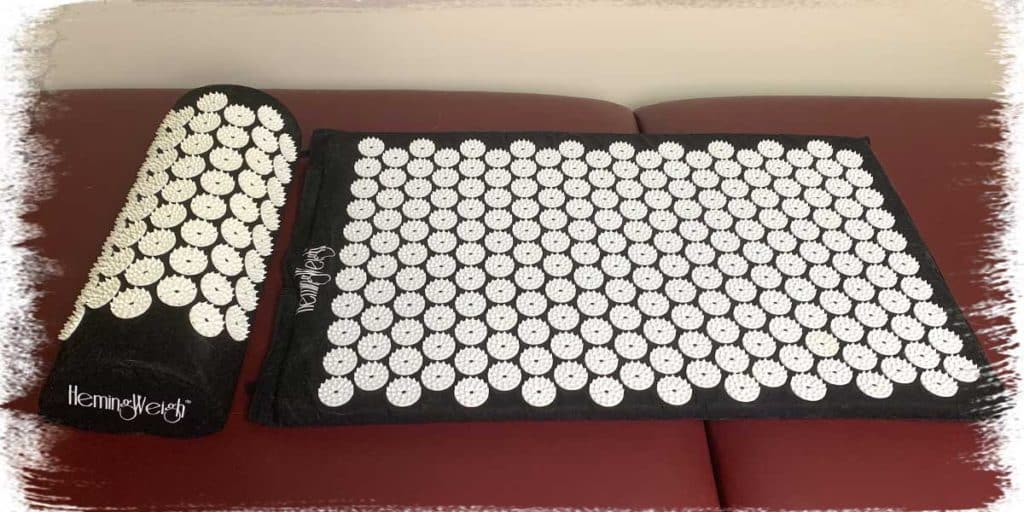
One of the most assured ways to get the most pain relief possible from your acupressure mat is to make sure that you use it consistently. Using it on an intermittent basis for an issue that is chronic (has been going on for months or more) likely won’t produce the results you’re looking for.
No one expects to only work out in the gym one time and immediately thereafter have their dream physique. Permanently eliminating or reducing pain or discomfort when using your mat should be met with the same sort of expectations.
You will stand a much better chance at reducing or eliminating pain if you use your acupressure mat consistently over a prolonged period of time.
It’s understandable to want pain to disappear as quickly as possible, but issues involving sore, tight and achy muscles tend to take regular treatment for a prolonged period of time before we notice the lasting effects that we’re after. You may likely notice transient pain relief each time after using the mat, which is of course awesome (and expected), but achieving lasting results will likely take regular consistent usage.
When it comes to using your mat, you may find it helpful to get into a routine using it. Depending on your own individual circumstances and condition, using your mat at least daily, if not more than one time per day may be ideal. As long as the mat isn’t making you feel worse each time you use it, you should be good for another session sooner rather than later.
Tip 2: Use it on multiple body parts
Another way to help ensure maximal pain-relieving benefits from your acupressure mat is to use it on body parts nearby the actual painful area, even if these nearby areas aren’t painful by themselves.
There are a few reasons for considering this. The first is that treating/stimulating nearby tissues, even if they’re not painful can still have a positive influence on the affected tissues. This is often termed “the ripple effect” by healthcare practitioners, where just as ripples move outward from where a rock is dropped in water, so too treatment benefits can “ripple outwards” from the epicenter of a treatment area to other tissues nearby.
So, if your painful area is your upper back, using your mat on your lower back and the back of your neck (using an acupressure neck roll, if you have one) could be a wise move to make.
As another example: if you are using the mat on your calves, you could also try using it on the bottoms of your feet and the back of your thighs (the hamstring muscles). All of these tissues share fascial connections and influencing one of them could perhaps help influence the others.
A second reason to treat multiple body parts is that it can help to provide a greater amount of endorphin release, leading to higher amounts of pain reduction for a duration of time after using the mat. With greater areas of the skin and body being stimulated by the acupressure spikes, a greater amount of subsequent therapeutic effect is likely to result. In this case, that result is the release of endorphins, which travel throughout the entire body.
With these endorphins traveling throughout the entire body, the result can not just be a localized reduction in pain, but also a systemic (body-wide) result as well.
Tip 3: Know how to vary the pressure
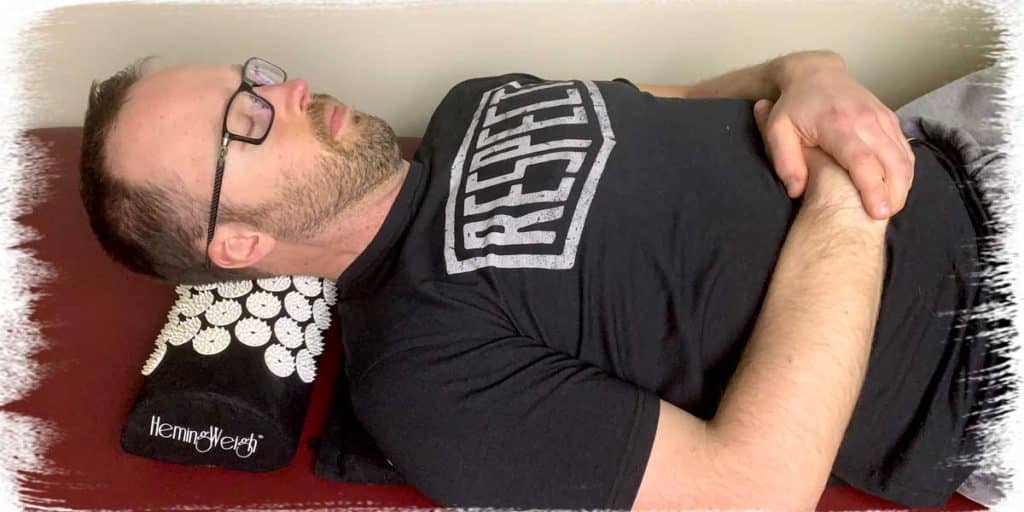
Knowing how to vary the pressure or intensity of the acupressure spikes can help ensure optimal treatment when using your mat. If the intensity is either too great (i.e. very uncomfortable) or isn’t strong enough, you may not get the desired therapeutic response that you’re after.
If the pressure or intensity is too great, you can put a thin layer of clothing between your skin and the mat. If you are laying down on the mat, this could be as simple as wearing a thin T-shirt, which will lessen the intensity of the acupressure spikes.
If you’re treating another body part, simply use a thin piece of fabric (again, a T-shirt draped around the body part works nicely). As time goes on with multiple sessions using your mat, you’ll likely find yourself no longer needing any clothing between your skin and the mat.
If the pressure isn’t enough (which is much rarer than it is too much), make sure that you’re using the mat on a hard surface. Laying down on a mat or putting pressure from another body part onto it when it’s resting on a soft surface (such as a bed mattress) will cause the mat to sink downwards, lessening the pressure of the mat’s spikes pushing into your skin.
Tip 4: Use it in conjunction with deep breathing exercises
It may sound crazy, but if you’re serious about maximizing pain relief while using your acupressure mat, you would be wise to incorporate a deep breathing routine into your mat routine whenever using it, particularly if you’re feeling stressed. Deep breathing plays an important role in pain relief since stress and pain lead to more shallow and rapid breathing patterns, which can increase tension in the neck, shoulders, and back.
Deep breathing has been shown to help activate the brain’s pain control center, which can help aid the process of relaxation (and thus pain reduction) by releasing the body’s own pain-relieving opiates, including serotonin as well as morphine.1
Keep in mind that pain can be quite complex and multifactorial in nature, so the scope of when and how deep breathing can exhibit pain-relieving benefits is well beyond this article. But if you’d like to read up more on this fascinating phenomenon, you can start by checking out the following journal articles:
- The effect of deep and slow breathing on pain perception, autonomic activity, and mood processing—an experimental study.2
- Can slow deep breathing reduce pain? An experimental study exploring mechanisms.3
- Relaxation & Pain Management: The relaxation response can play a role in managing chronic and acute pain.4
Ultimately, you can think of deep breathing as taking a “pain pill”, where one “pill” equals somewhere around six to ten breaths. This is a concept that is explained really well in the book A World of Hurt: A Guide to Classifying Pain by Melissa Kolski and Annie O’Connor (it’s aimed more at the clinician than the layperson, just as an FYI).
Our body really is an amazing machine that has some amazing ways to heal and decrease pain, and deep breathing is an amazing tool that goes well with the therapeutic effects of using an acupressure mat.
Tip 5: Keep using it to prevent the problem from returning
If you’re serious about maximizing the therapeutic effects of your acupressure mat, it would be a wise idea to continue using your mat on at least a somewhat regular basis even after you feel like the issue causing your pain has been remedied.
One of the biggest mistakes individuals make when trying to eliminate pain is the erroneous thought that treatment is no longer needed once the pain is absent.
While there certainly comes a point in recovery where this is true, don’t make the mistake of ceasing your treatment routine with your mat after you experience your first pain-free day. The reason being that as tissues in the body begin to get healthier, they initially become healthy enough to not produce pain but still undergo a duration of time in which they aren’t yet back to full health.
Related article: Massage Gun vs Vibrating Foam Roller – is One Better than the Other?
Think of it like your car: just because your car’s engine is running doesn’t necessarily mean that it has a full tank of gas to work with – it may in fact be running on fumes with only a few more minutes remaining before it stalls.
When it comes to the health of your tissues, you want them to have a “full tank of gas”, so to speak, in order to ensure that pain and discomfort won’t return.
Try to keep using your mat for a handful of weeks after you’re no longer having pain or feeling tight in the area. From there, you can begin to space out and reduce your treatment frequency as you see fit to do so. But if you cease too quickly altogether, you may find that the issue comes back rather quickly and effortlessly.
Bonus tip: Use an acupressure neck roll on your low back
If you’re wanting to use an acupressure mat on your lower back, or if you’ve been experiencing back pain while sitting, an acupressure neck roll can not only serve as a great way to get acupressure benefits to this region, but it can also double as a great lumbar support in the process.
A lumbar support is simply an object that is placed behind one’s low back when sitting in a chair. It helps to maintain a much healthier position for the lumbar spine (the bottom five bones of our vertebrae). They serve as great reminders for our brain to hold a different (and subsequently better) posture for our lower back when sitting while also offering physical support for maintaining these positions.
If you have a neck roll/neck pillow with acupressure spikes on it, you may find that it’s the perfect size for stuffing behind your lower back in order to serve as a lumbar support when sitting in a chair. Leaning back into the roll will then simultaneously provide the therapeutic benefits mentioned previously within this article.
Related Article: How to Fix Your Posture While Sitting at Your Desk (Five Proven Tips)
If sitting down isn’t your thing, you can opt to place the neck roll on your low back while laying down and relaxing. This should still feel quite nice while providing the same physiological benefits.
Not a bad little two-for-one, eh?
Final thoughts:
Acupressure mats are pretty handy to have, especially when you just want to lay down and relax while receiving some pain-relieving benefits in the process. If you’re looking to get the most out of your mat, make sure to follow the tips mentioned in this article in order to experience as much pain relief as possible.
References:
1. Zubieta J-K, Bueller JA, Jackson LR, et al. Placebo effects mediated by endogenous opioid activity on μ-opioid receptors. J Neurosci. 2005;25(34):7754-7762.
2. Busch V, Magerl W, Kern U, Haas J, Hajak G, Eichhammer P. The effect of deep and slow breathing on pain perception, autonomic activity, and mood processing—an experimental study. Pain Med. 2012;13(2):215-228.
3. Jafari H, Gholamrezaei A, Franssen M, et al. Can slow deep breathing reduce pain? An experimental study exploring mechanisms. J Pain. 2020;21(9-10):1018-1030.
4. Schaffer SD, Yucha CB. Relaxation & Pain Management: The relaxation response can play a role in managing chronic and acute pain. AJN Am J Nurs. 2004;104(8):75-82.

Hi! I’m Jim Wittstrom, PT, DPT, CSCS, Pn1.
I am a physical therapist who is passionate about all things pertaining to strength & conditioning, human movement, injury prevention and rehabilitation. I created StrengthResurgence.com in order to help others become stronger and healthier. I also love helping aspiring students and therapists fulfill their dreams of becoming successful in school and within their clinical PT practice. Thanks for checking out my site!

